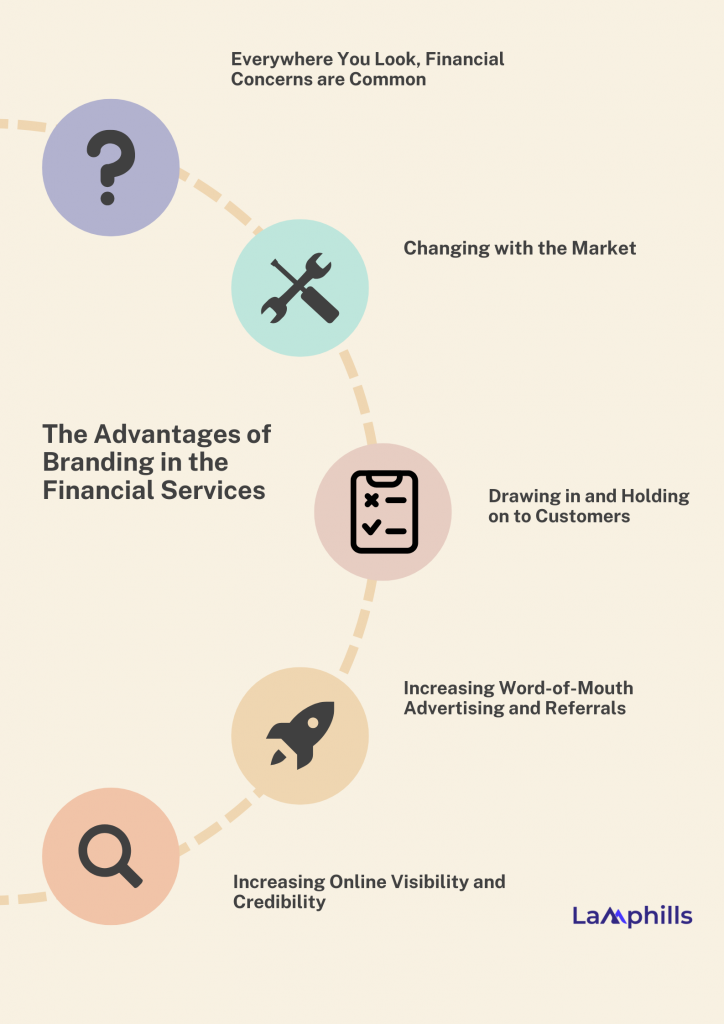A strong brand strategy is the foundation of success in the fiercely competitive business and financial services industry. But what is branding in the first place? Simply put, a branding strategy is about creating a distinctive identity that stands out in the market. It is also about building confidence with investors and drawing in customers rather than just logos and color schemes.
So, you see, the importance of branding can not be overstated. In fact, there’s a comprehensive list of them. Based on my experience writing content for personal and company brands in both the business and financial services industry in the last decade, I will walk you through the essential elements of branding and its importance in this article.
Key Takeaways
- Determining what makes your brand unique is the foundation for more compelling and successful marketing
- Branding encompasses everything from a company’s tone and voice to its logo, corporate design, and social media content.
- A clearly defined target population guarantees individualized and effective communication
- Building a positive brand image for banks requires constant moral behavior and open communication to alter public opinion.
- Effective branding is essential to be competitive and keep up with business developments.
What is Branding in Financial Services?
When I talk about branding, I mean everything that can help a company obtain awareness.
Branding helps increase and retain your client base. It should also provide financial value, build trust, and obtain employee buy-in.
A corporation should live and breathe its brand image in all it does, from service delivery to client interaction. Over time, this will lead to greater comprehension and recognition. This leads to both conscious and unconscious links between the company and its branding.
How to Create a Brand Strategy for Financial Services
Creating a financial services brand strategy necessitates a methodical approach that effectively communicates your brand’s essence to your target customer. Even though it may seem challenging, organizing a round-table workshop or providing a way for stakeholders and important executives from across your company to share their various points of view is crucial to identifying the subtle “reasons why” that will ultimately inform everything you do, including your marketing strategy, brand guide, and taglines.
This procedure can be the cornerstone of a plan to propel any financial brand into higher success.
#1. Establish a Distinctive Role
Differentiation is essential in a congested market like the financial services industry. Determining what makes your brand unique is the foundation for more compelling and successful marketing.
Even if your brand provides a comparable solution to what the market offers, you might be able to differentiate yourself from the competition by delivering the good or service or developing a unique brand story.
#2. Calculate and Modify
The previous procedure will give you a head start on your strategy because they will be based on an accurate target market and knowledge of the habits and desires of your ideal clients. However, measurement and course correction can only happen once you execute. Customer behavior and feedback will subsequently fill in the remaining details.
#3. Establish Your Brand’s Objectives
Setting clear goals and a mission for your brand is the greatest place to start. A well-defined mission statement guides all brand initiatives, guaranteeing that each contributes to a single goal, message, and united brand voice.
#4. Establish Your Fundamental Identity
You can now create a powerful identity, voice, and message from your unique position. A consistent brand identity increases brand recognition and helps you connect with consumers.
And to help you set the tone, here is a brand health survey template to help you do a bit of analysis with the goal of putting you on the right part.
Brand Health Survey Template.pdf
#5. Determine Who Your Target Market Is And Its True Needs
You will never succeed in persuading people to buy something they don’t desire, no matter how much money is spent on advertising.
A clearly defined target population guarantees individualized and effective communication, enabling you to capitalize on consumer needs currently in the market and ensure your advertising has the most significant impact and return on investment.
So, conduct in-depth research to understand your audience’s requirements, preferences, and behaviors. Surveys, focus groups, and market analysis might be used to obtain information about possible customers.
#6. Implement Your Strategy
Now that your plan has been established, it’s time to implement it. Create a brand kit, ensure all your touchpoints are consistent, and launch your brand with a well-thought-out strategy.
Create a launch plan outlining the rollout stages, beginning with an internal campaign to acclimate staff to the new approach and concluding with a public debut.
How do you get started with this?
Here is a checklist to help you through each stage of the brand launch process, ensuring no details are forgotten. From the initial research and planning stages to the grand reveal and beyond, I’ve covered every crucial step required to make a memorable and compelling brand debut. Following this roadmap will allow you to lay a solid basis for your brand, effectively engage your target audience, and maintain a long-term presence in the market.
Brand Launch Checklist.pdf
The Disadvantages of Branding Financial Services
Yes, building a good brand in the banking sector can be difficult for various reasons.
#1. Advances in Technology
Branding initiatives must constantly adapt to technological developments to incorporate them. Banks must have a strong online presence and offer digital banking services that adapt to clients’ changing needs to remain relevant in the digital age.
#2. Increasing Rivalry
It faces growing competition as the financial sector attracts more participants. As more players enter the market, banks must develop creative ways to set themselves apart and develop a distinctive brand identity that appeals to their target market. To gain a competitive advantage, one must stand out.
#3. Brand Uniformity
The emergence of multichannel banking presents a difficulty in upholding a unified brand identity across all channels. Regardless of the channel, customers should receive the same brand identity and values, whether interacting with physical branches, internet banking, or mobile apps.
#4. Focus on the Customer
Financial services must balance their brand to meet clients’ demands and expectations as they shift to a customer-centric strategy. This necessitates a greater comprehension of consumer behaviors and preferences and the capacity to customize goods and services to fulfill these demands.
#5. Fighting Unfavorable Perceptions
Developing Credibility and a Positive Reputation Negative perceptions of the financial sector, such as greed and unethical behavior, are common. Building a positive brand image for banks is a huge issue that lies ahead. Customer trust must be earned, which requires constant moral behavior and open communication to alter public opinion.
The Advantages of Branding in the Financial Services

Financial services organizations may differentiate themselves and communicate their narrative through branding to stand out from the plethora of similar logos and messaging, which is crucial in today’s competitive landscape. Honesty and transparency in branding can increase customer trust and remove any reservations about their financial situation.
#1. Everywhere You Look, Financial Concerns are Common
According to 73% of Americans, money is their most significant source of stress. Therefore, by positioning oneself as a resource and mentor in demystifying money, finance advisory organizations, and professionals have the chance to reduce anxiety. By building a brand that resonates with clients deeply, these firms may help individuals reach their financial objectives.
Incorporating personal involvement in the community or legacy-giving programs fosters familiarity and connection. By establishing connections and sharing personal experiences, a fan base is created that will recommend the adviser or firm to others.
Regarding branding for financial services, accessibility and relevance are crucial. Businesses and consultants are required to provide timely information that enables consumers to make wiser financial decisions. Building a reputation for thought leadership with pertinent content increases traffic and forges enduring relationships. Retaining customers and enhancing the brand’s credibility also depends on proactive outreach, timely communication, and consistent messages.
#2. Changing with the Market
Effective branding is essential to be competitive and keep up with business developments. Advisors can gain insight into certain target audiences’ changing demands and preferences by regularly tracking market trends and consumer data.
Being aware of this can assist financial firms in making deft choices regarding how to adapt their offerings, presentations, and services to meet the needs of the growing market.
PayPal is a prime example of a company that uses branding to adapt to change. It changed its branding to highlight simplicity and security across multiple digital platforms after seeing the growing popularity of mobile transactions. Initially, their primary focus was on facilitating Web payments.
Their ongoing success has been attributed to their capacity to adjust and match their brand with shifting market conditions.
#3. Drawing in and Holding on to Customers
Any business’s ability to attract and retain consumers is essential; in the financial industry, strong branding is critical to this goal. It takes more than a memorable logo or catchy phrase to communicate knowledge and specialization effectively.
Branding makes that feasible. Whether a person specializes in investing techniques, retirement planning, or wealth management, their branding should demonstrate their in-depth understanding of those fields to prospective clients, giving them confidence when they ask for advice.
Effective branding involves more than just technical know-how; it also involves emotionally engaging and connecting with customers. People make financial decisions based on various factors, including goals, dreams, and concerns. By utilizing these tools, anyone can establish a strong relationship with clients.
#4. Increasing Word-of-Mouth Advertising and Referrals
For financial organizations, word-of-mouth advertising and referrals are extremely valuable. When pleased customers promote advisers and firms to others and speak about of their services, this broadens the professional network and enhances reputation.
Firstly, the key to getting recommendations is to provide outstanding service and deliver outcomes. Client satisfaction becomes a potent instrument for drawing in new business when they have a great experience and, with the help of expert coaching, meet their financial goals. These satisfied customers become enthusiastic brand ambassadors.
Creating an above-average referral program and providing discounts or incentives might inspire customers to actively promote a business to their networks to increase referrals. This procedure can be streamlined by establishing a reliable referral program, making it simpler for clients to manage prizes and share referrals. Asking delighted customers for testimonials or online reviews can also be very helpful as they provide social evidence and enhance reputation.
#5. Increasing Online Visibility and Credibility
To succeed in this day and age, a business needs to have a strong internet presence. These days, having a website and social media accounts is insufficient; to maximize and successfully manage one’s online reputation, one must also have a well-coordinated brand plan.
By coordinating a message, visual identity, and tone, a cohesive marketing strategy guarantees consistency across all online channels and gives a target audience an unforgettable brand experience. Online users begin to recognize and trust you when you are consistent.
Moreover, this approach is about more than just aesthetics. Bad word of mouth may swiftly damage a business’s image if it is not addressed, and effective branding controls and shapes reputation to facilitate information traveling quickly.
Vanguard, a well-known investment management firm, has established a strong online presence and reputation by constantly delivering insightful material on its website and social media channels. Their marketing strategies emphasize informing and enhancing investors’ self-assurance, establishing them as a reliable source in the industry.
What is branding in financial services?
The process of developing a reliable brand for a financial organization, like a bank or investment firm, to increase client loyalty and confidence is known as financial branding. It’s more than simply a catchphrase or logo, and the success of a financial services company depends on it. A company’s brand expresses its principles, culture, and commitment to its customers.
What is the relationship between branding and finance?
Even if capital is crucial for a business, strong branding and marketing propel and sustain a company. Branding is done to keep the company’s worth from declining once it is established and begun operations.
Conclusion
In conclusion, in today’s cutthroat industry, bank branding is critical and should not be undervalued. Banks may stand out from the competition, win over consumers’ confidence and loyalty, and eventually spur corporate expansion with the support of a great brand.
Nonetheless, it is imperative that banks carefully manage the difficulties associated with building a strong brand while also using its benefits. Therefore, for financial institutions hoping to thrive in the current market, investing in bank branding ought to be their first concern.
Related Articles
- How to Become a Financial Journalist
- Top Rebranding Strategies That Sparks Massive Business Growth
- Branding Sentiment Analysis: Everything You Should Know
- Public Relations Services: Trusted Public Relations Strategies for Success
- Public Relations Services: Trusted Public Relations Strategies for Success






